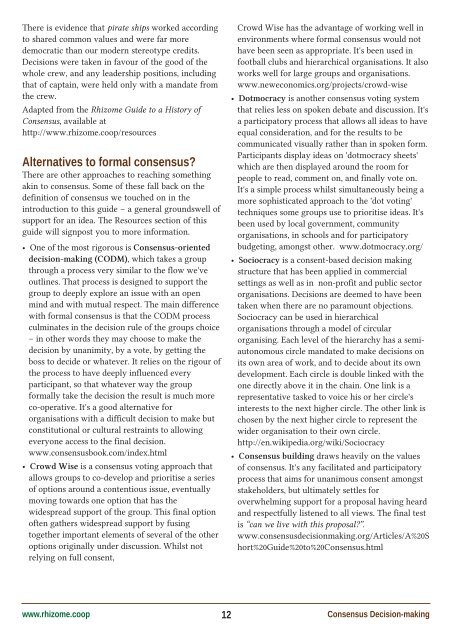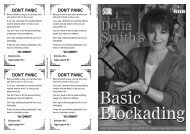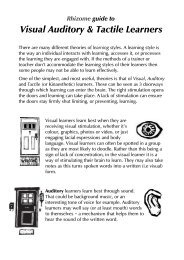Consensus Decision-making - Rhizome
Consensus Decision-making - Rhizome
Consensus Decision-making - Rhizome
You also want an ePaper? Increase the reach of your titles
YUMPU automatically turns print PDFs into web optimized ePapers that Google loves.
There is evidence that pirate ships worked accordingto shared common values and were far moredemocratic than our modern stereotype credits.<strong>Decision</strong>s were taken in favour of the good of thewhole crew, and any leadership positions, includingthat of captain, were held only with a mandate fromthe crew.Adapted from the <strong>Rhizome</strong> Guide to a History of<strong>Consensus</strong>, available athttp://www.rhizome.coop/resourcesAlternatives to formal consensus?There are other approaches to reaching somethingakin to consensus. Some of these fall back on thedefinition of consensus we touched on in theintroduction to this guide – a general groundswell ofsupport for an idea. The Resources section of thisguide will signpost you to more information.• One of the most rigorous is <strong>Consensus</strong>-orienteddecision-<strong>making</strong> (CODM), which takes a groupthrough a process very similar to the flow we'veoutlines. That process is designed to support thegroup to deeply explore an issue with an openmind and with mutual respect. The main differencewith formal consensus is that the CODM processculminates in the decision rule of the groups choice– in other words they may choose to make thedecision by unanimity, by a vote, by getting theboss to decide or whatever. It relies on the rigour ofthe process to have deeply influenced everyparticipant, so that whatever way the groupformally take the decision the result is much moreco-operative. It's a good alternative fororganisations with a difficult decision to make butconstitutional or cultural restraints to allowingeveryone access to the final decision.www.consensusbook.com/index.html• Crowd Wise is a consensus voting approach thatallows groups to co-develop and prioritise a seriesof options around a contentious issue, eventuallymoving towards one option that has thewidespread support of the group. This final optionoften gathers widespread support by fusingtogether important elements of several of the otheroptions originally under discussion. Whilst notrelying on full consent,Crowd Wise has the advantage of working well inenvironments where formal consensus would nothave been seen as appropriate. It's been used infootball clubs and hierarchical organisations. It alsoworks well for large groups and organisations.www.neweconomics.org/projects/crowd-wise• Dotmocracy is another consensus voting systemthat relies less on spoken debate and discussion. It'sa participatory process that allows all ideas to haveequal consideration, and for the results to becommunicated visually rather than in spoken form.Participants display ideas on 'dotmocracy sheets'which are then displayed around the room forpeople to read, comment on, and finally vote on.It's a simple process whilst simultaneously being amore sophisticated approach to the 'dot voting'techniques some groups use to prioritise ideas. It'sbeen used by local government, communityorganisations, in schools and for participatorybudgeting, amongst other. www.dotmocracy.org/• Sociocracy is a consent-based decision <strong>making</strong>structure that has been applied in commercialsettings as well as in non-profit and public sectororganisations. <strong>Decision</strong>s are deemed to have beentaken when there are no paramount objections.Sociocracy can be used in hierarchicalorganisations through a model of circularorganising. Each level of the hierarchy has a semiautonomouscircle mandated to make decisions onits own area of work, and to decide about its owndevelopment. Each circle is double linked with theone directly above it in the chain. One link is arepresentative tasked to voice his or her circle'sinterests to the next higher circle. The other link ischosen by the next higher circle to represent thewider organisation to their own circle.http://en.wikipedia.org/wiki/Sociocracy• <strong>Consensus</strong> building draws heavily on the valuesof consensus. It's any facilitated and participatoryprocess that aims for unanimous consent amongststakeholders, but ultimately settles foroverwhelming support for a proposal having heardand respectfully listened to all views. The final testis “can we live with this proposal?”.www.consensusdecision<strong>making</strong>.org/Articles/A%20Short%20Guide%20to%20<strong>Consensus</strong>.htmlwww.rhizome.coop12 <strong>Consensus</strong> <strong>Decision</strong>-<strong>making</strong>





